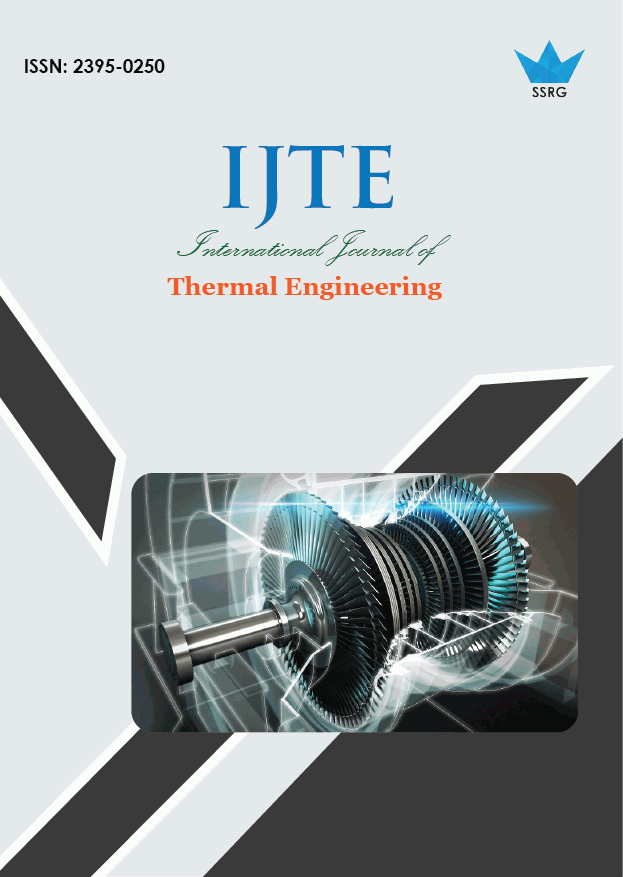Thermal Force Storage Scheme Using Phase Modify Equipment – Invariable Heat Resource

| International Journal of Thermal Engineering |
| © 2015 by SSRG - IJTE Journal |
| Volume 1 Issue 1 |
| Year of Publication : 2015 |
| Authors : Dr.V.Thiruvasagam, G.Jagadees |
How to Cite?
Dr.V.Thiruvasagam, G.Jagadees, "Thermal Force Storage Scheme Using Phase Modify Equipment – Invariable Heat Resource," SSRG International Journal of Thermal Engineering, vol. 1, no. 1, pp. 9-14, 2015. Crossref, https://doi.org/10.14445/23950250/IJTE-V1I1P103
Abstract:
The practice of phase modify materials to accumulate the heat in the appearance of latent heat is augmented, for the reason that large capacity of thermal force is stored in smaller volumes. In the nearby experimental exploration paraffin and standing acid are engaged as modify materials in thermal power storage system to store the heat as reasonable and concealed heat moreover. An invariable heat resource is used to provide heat relocate fluid at invariable warmth to the thermal energy storage scheme. In the thermal energy storage method change materials are stored in the form of globular capsules of 45 mm diameter made of elevated concentration poly ethylene. The consequences of the exploration are associated to the charging time and improvement of stored energy from the thermal force storage scheme. Storage mediums consist of: water or ice-slush tanks ranging from diminutive to massive, masses of native earth or bedrock accessed with heat exchangers in clusters of small-diameter boreholes; deep aquifers controlled between impervious strata; superficial, lined pits overflowing with gravel and water and top-insulated; and eutectic, phase-change equipments.
Keywords:
phase change material, latent heat, heat transfer fluid, paraffin, static acid, thermal energy storage, constant heat source.
References:
[1] Meenakshi Reddy Reddigari A , Nallusamy B, Anjaneya Prasad Bappala C, And Hemachandra Reddy Konireddy, Thermal Energy Storage System Using Phase Change Materials – Constant Heat Source, Thermal Science: Year 2012, Vol. 16, No. 4, Pp. 1097-1104.
[2] Nallusamy, N., Effective Utilization of Solar Energy for Water Heating Applications using Combined Sensible and Latent Heat Storage System, Proceedings, International Conference on New Millennium Alternate Energy Solutions for Sustainable Development, PSG Tech, Coimbatore, Tamil Nadu, India, 2003, pp. 103-108.
[3] Ettouney, H. M., et al., Heat Transfer Enhancement in Energy Storage in Spherical Capsules Filled with Paraffin Wax and Metal beades, Energy Conversion and Management, 47 (2006), 2, pp. 211-228.
[4] Watanabe, T., Kikuchi, H., Kanzawa, A., Enhancement of Charging and Discharging Rates in a Latent Heat Storage System by use of PCM with Different Melting Temperatures, Heat Recovery Systems and CHP, 13 (1993), 3, pp. 57-66
[5] Farid, M. M., Kim, Y., Kanzawa, A., Thermal Performance of a Heat Storage Module Using PCM’S with Different Melting Temperatures: Experimental, Journal of Solar Energy Engineering, 112 (1990), 2, pp. 125-131.
[6] Cho, K., Choi, S. H. Thermal Characteristics of Paraffin in a Spherical Capsule during Freeing and Melting Processes, Int. J. Heat and Mass Transfer 43 (2000), 17, pp. 3183-3196.
[7] Mehling, H., et al., PCM-Module to Improve Hot Water Heat Stores with Stratification, Renewable Energy, 28 (2003), 5, pp. 699-711.

 10.14445/23950250/IJTE-V1I1P103
10.14445/23950250/IJTE-V1I1P103